Kuwait’s enthusiastic assistance for recovery from Great East Japan Earthquakes
By Ikuzo Kobayashi, President of Salaam Association
From “Salaam Quarterly Bulletin” Summer Issue, May 2014
Three years have transpired since the Great East Japan Earthquakes. The path to the recovery from the disasters has been opened up gradually although there are still many challenges to overcome.
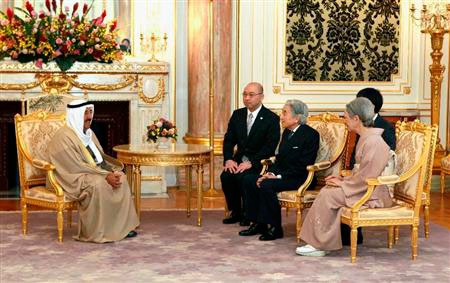
On March 21,2012, the Emperor and the Empress had a talk with the Amir of the State of Kuwait Sheikh Sabah who was visiting Japan as a state guest.The Majesty showed his appreciation towards donating 500 barrels of crude oil to support for the Great East Japan Earthquake.(from the official site of the Imperial Household Agency)
While there was much publicity about the donation of 10 billion yen from Taiwan which led to Taiwan boom among people in Japan, not much has been reported about a large-scale crude oil gift from Kuwait in the amount of 5 million barrels (equivalent to 40 billion yen). It was recently reported that the total recovery of Sanriku Railway completed on April 6 was made possible by the donation from Kuwait. The donation from Kuwait was used not only for Sanriku Railway but other projects as well. This issue features enthusiastic support from Kuwait.
“One drop of oil” resulted in 5 million barrels
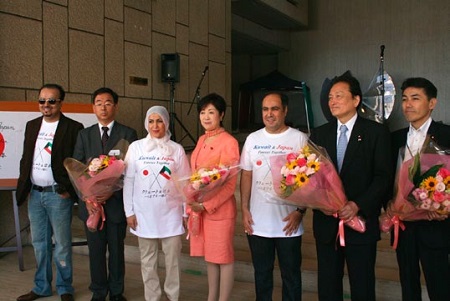
“Charity Bazaar to Aid Victims of the Great East Japan Earthquakes” sponsored by the Kuwaiti Embassy on May 14. 2011. From right to left in the photo, starting with the second person, Parliamentary Vice-Minister of Economy, Trade and Industry Yoshikatsu Nakayama, Ambassador Al-Otaibi, Diet Member Yuriko Koike, and Mrs. Jamilah Al-Otaibi
Kuwait celebrated 50-year anniversary of national independence and 20-year anniversary of liberation from Iraq after the Gulf War in 2011. Many celebration events were planned in Japan and Kuwait in that year centered on those anniversaries. However, those celebration events in Japan were canceled due to the Great East Japan Earthquakes on March 11, 2011.
In 2011, “Charity Bazaar to Aid Victims of the Great East Japan Earthquakes” was held on May 14, 2011 under the sponsorship of the Kuwait Embassy in Japan. The day of the event was a sunny day, and the ground of the embassy located in Mita, Minato-ku, Tokyo was filled with participants by 10 am when the ceremony started.
Kuwaiti Ambassador to Japan Abdulrahman Al-Otaibi greeted and opened the ceremony after a silent prayer. He said, “We continued our daily operation after the disaster with support from our staff and my country, and I toured the disaster area two weeks ago.” Next, Diet Member Yuriko Koike (then General Council chairman of the Liberal Democratic Party and currently Director of Public Affairs of the LDP) explained the background behind the Kuwaiti assistance. She said, “Ambassador Al-Otaibi himself visited my office on April 1 and asked me what he can do for Japan. In reply, I asked the ambassador to provide ① “one drop of oil” and that led to the gift of 5 million barrels of oil (equivalent to 40 billion yen) from Kuwait to Japan.” Participants enthusiastically applauded.
① “One drop of oil”: French Prime Minister Clemenceau wrote “One drop of oil is equivalent to one drop of blood in value” in his telegram addressed to the U.S. Presindet Wilson in 1917 during the World War I. It is said that the victory or defeat of the war depended on oil. This phrase was spread in Japan as “One drop of oil is one drop of blood” during the World War II.
5 million barrels filled with heart of gratitude

Ambassador Otaibi helped selling items in the Bazaar.
Then Japanese Ambassador to Kuwait Yasuyoshi Komizo (currently the Chairperson of Hiroshima Peace Culture Foundation says, “After the earthquake and tsunami disasters, there was tremendous outpouring of support for Japan including charity concerts. I personally conveyed my gratitude to those supporters, especially the youth one by one. As the results, I think I met more than 1,000 Kuwaitis in two months.”
There is no doubt that Diet Member Koike’s reply about “one drop of oil” was conveyed to Kuwait through the ambassador. However, it was the Amir of the State of Kuwait himself who made a decision to send the gift of 5 million barrels of oil. Former Ambassador Komizo says, “The gift of 5 million barrels of oil was equivalent to 40 billion yen back then. It has been said that Taiwan provided the biggest amount of donation to Japan, but the total amount of Taiwan’s donation is 10 billion yen. The eldest brother among Gulf nations is Saudi Arabia. Under the ordinary circumstances, if Saudi Arabia donates 10, it is an established courtesy that Kuwait, Oman or UAE donates 6 or 7. However, Kuwait made a donation that is more than 20 times larger than Saudi donation.”
“This is Kuwait’s expression of gratitude for Japan’s 13 billion dollar aid to Kuwait when Kuwait was invaded by Iraq. When one is appointed as an ambassador, he goes through a ceremony to hand the credential issued by the Emperor of Japan to the head of state of the country of assignment. The time allowed for the ceremony is 10 minutes with interpreting, so in essence it is only 5 minutes, During the ceremony, the Amir Al-Sabah of the State of Kuwait told me, ‘I have never forgotten that we are indebted to Japan. ② At the time of Iraqi invasion of Kuwait, Japan provided the aid of 13 billion dollars. We will repay Japan’s favor by all means.'”
② When Iraq invaded Kuwait, Japan donated money for the campaign of the multi-national forces to expel Iraqi forces, but Japan did not dispatch Self Defense Force soldiers. After liberation of Kuwait, Kuwait contributed an article of gratitude to the New York Times and other media. Japan was not mentioned in the article. The Amir’s words are understood to mean that “The nation and people of Kuwait know Japan’s aid (the fact that Japan contributed 13 billion dollars) and never forget Japan’s favor.”
“Subsequently, when the disaster hit Japan, it was proposed to provide Japan with a gift of 5 million barrels of oil under the direction of the Amir. When my tenure as the ambassador ended, I personally conveyed a gratitude for that gift to the Amir. At that time, then Kuwaiti foreign minister told me, ‘Certainly, Japan is going through difficult time, but it was also tough for Kuwait. There is a possibility that the government might collapse due to a gift of oil. In the past, the government collapsed multiple times. The government takes such risk. Kuwait is a rich nation but about 90% of the nation’s natural resources is oil and diversification of the nation’s revenue sources is difficult. In other words, Kuwait has only oil, which is our last resort. The government collapsed time and time again because it did not use oil properly. So, it took one month to reach a decision. However, the final decision was made by the Amir himself. The parliament said if the gift is for Japan, they would not oppose.”
The government of Kuwait announced its intention to “provide a gift of 5 million barrels of crude oil” based on the order from the Amir Al-Sabah in April, 2011.
Arrival of a tanker carrying crude oil for recovery support
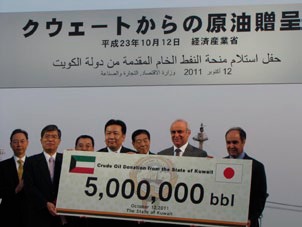
Ceremony for the gift of crude oil from Kuwait.
From left to right on the front row in the photo, Parliamentary Vice-Minister of Foreign Affairs Kato, Minister of Economy, Trade and Industry Edano, Chairman of KPC Al-Zanki, and Ambassador Al-Otaibi.
Tankers carrying the first shipment of crude oil for recovery aid arrived at Negishi Refinery of JX Nippon Oil & Energy in Yokohama. The ceremony commemorating the gift was held under the auspices of then-Minister of Economy, Trade and Industry Yukio Edano, on October 12, 2011.
Then-Minister Edano said, “Kuwait remembers Japanese aid at the time of Iraqi invasion of Kuwait 20 years ago and is repaying Japan’s favor this time. We are deeply moved by this.” Japan Red Cross Society President Tadateru Konoe said, “For the first time in 134-year history of Japan Red Cross Society, we received crude oil as a conation. The aid from Kuwait will be a ray of hope for people in the disaster area.” (Japan-Kuwait Society Bulletin No. 227)
Ambassador Al-Otaibi said, “This donation was ordered by H.H. the Amir Sheikh Sabah Al-Ahmad Al-Sabah as a support and assistance from the people of the State of Kuwait to their friends the people of Japan. This is an example of the mutual help and support that Japan and Kuwait affected to each other over the years. We, in the State of Kuwait, cannot forget the support that Japan has offered to us since the independence of our country.”
5 million barrels of crude oil is more than Japan’s daily crude oil consumption which is 4.4 million barrels and is equivalent to 500 million dollars with current crude oil price. It was decided that the entire crude oil provided as a reconstruction aid would be delivered to four refineries in Japan in 2011, and sold to Japanese oil companies by Kuwait Petroleum Corporation (KPC). The sum of the sales which is about 40 billion yen would be channeled to Iwate, Miyagi and Fukushima Prefectures via Japan Red Cross Society.
According to the announcement of Japan Red Cross Society, on January 6, 2012, “about 8.4 billion yen, 16.2 billion yen and 15.4 billion yen were remitted to Iwate, Miyagi and Fukushima Prefectures respectively, namely 40 billion yen in total was remitted. Allocation was decided through consultation with Ministry of Economy, Trade and Industry and other relevant agencies.” The remitted reconstruction aid money is accumulated in each prefecture as the reconstruction fund and utilized in ③ eight fields based on the resolution by each prefectural assembly.
③ 8 fields: (1)Reconstruction of local infrastructure (2) Medical assistance (3) Welfare and custodian care assistance (4) Education assistance (5) Agriculture, forestry and fishery assistance (6) Small and mediumsized enterprises assistance (7) Employment assistance (8) Nuclear accident victims assistance.
Sanriku Railway becoming a symbol of reconstruction
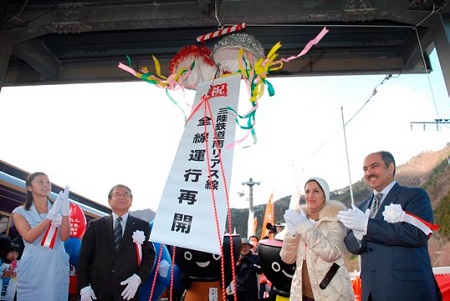
At Kamaishi Station on April 5. Braking of a decorative paper ball for festivities commemorating resumption of operation of the entire Sanriku Railway Minami Rias Line. From right to left in the photo, Kuwaiti Ambassador and his wife, Iwate Prefectural Assembly President Hiroshi Sasaki, and Japan Red Cross Special Public Relations Envoy Norika Fujiwara.
Restoration of the entire railroad track of Sanriku Railway is a blight news story that gives hope for reconstruction three years after the Great East Japan Earthquakes. Especially, 8 railcars purchased with a donation of crude oil from Kuwait were featured in news stories of television and other media, as if they are carrying the spirit of enthusiastic support from Kuwait.
Sanriku Railway was established as the first third sector in Japan in 1984. It provided transportation for local high school students and senior citizens. Under the management after transition to a third sector system, the railway is divided into two companies, a relatively healthy company and a struggling company. Sanriku Railway had continued to generate profits for the first 10 years since its establishment with enthusiastic support from local community, but subsequently faced difficulties financially. The railway came up with unique ideas and was about to overcome financial difficulties when the earthquakes hit the region.
The railway was planned with a policy to realize “a stable public transit system that can be operated even in tsunami disasters” and its railroad track was constructed by the mountain which is furthest from oceans. However, the disasters caused by the great earthquakes and tsunami were beyond human imagination. The land bridges constructed with 20-meter-high tsunami wave were completely devastated by tsunami waves that were 25-meter-high.
Tenacity for restoration
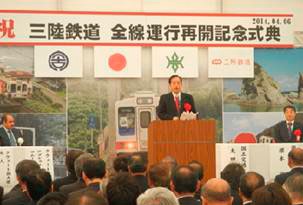
Akihiro Ota, Minister for Land, Infrastructure, Transport and Tourism, is making a congratulatory remark at the ceremony of total resumption of Sanriku Railway on April 6, 2014. Kuwaiti Ambassador to Japan Abdulrahman Al-Otaibi(left) was invited as donor.(from home page of MLIT)
President Masahiko Mochizuki of Sanriku Railway said, “Out of total 107.6 km length of north-south railroad tracks along deeply-indented coastline, only 5.8 km portions were damaged by the earthquakes this time. The most of the damages were caused by earthquakes.” On March 16, only five days after the earthquakes, operation of the railroad section between Kuji and Rikuchu-Noda was resumed. Operation in the section between Miyako and Taro was restored on March 20, and between Taro and Omoto on March 25. President Mochizuki said, “I want to expedite restoration by using all available means,” and made efforts with aim at restoration of entire railroad tracks in three years. South Rias Line and Kita Rias Line were completely restored on April 5 and 6, 2014 respectively. Sanriku Railway is the pioneering restoration project in the post-Great East Japan Earthquakes reconstruction.
Special railcars built by the enthusiastic support from Kuwait
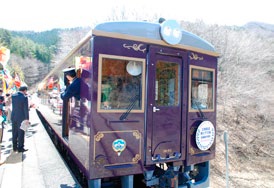
Kuwait national emblem painted on the front and rear of the railcars.
8.4 billion yen out of 40 billion yen aid from Kuwait was allocated to Iwate Prefecture. The money was used for Sanriku Railway through purchase of eight railcars and restoration of damaged stations and facilities at five locations. The money used for purchase of new railcars is estimated to be about 1.3 billion yen (160 million yen per railcar x 8 railcars). Kuwaiti national emblem is painted on the front and rear of the special train composed of eight railcars and a message “We greatly appreciate the support from the State of Kuwait” is written on the side of railcars in Japanese, English and Arabic.
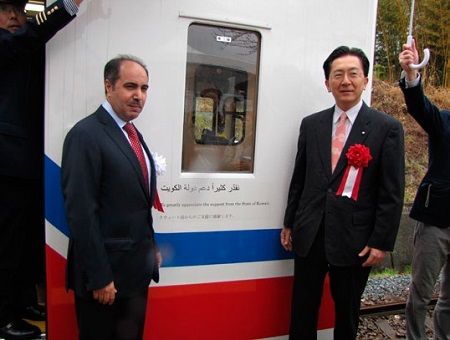
Railcars with a message “We greatly appreciate the support from the State of Kuwait” in Arabic, English and Japanese.
Sanriku Railway beloved by the local people as local means of transportation attracted many railway fans with unique ideas. Now it has become a symbol of restoration and reconstruction enthusiastically supported by the state and people of Kuwait.
From now on, tourists visiting the area from different parts of the world will come to know the ties between Sanriku Railway and Kuwait and discover the heart of Japanese people’s gratitude for the support from the international community.
Memorial Garden for Kuwait Fukushima Friendship

Samegawa Stone Monument. An Arabic word “Salaam (Peace)” is carved.
On February 24, 2014, “Celebration Party Commemorating 53rd Anniversary of Kuwait National Foundation and 23rd Anniversary of Liberation of Kuwait” was held at newly renovated Palace Hotel. Kuwaiti Ambassador and his wife as well as Embassy staff lined up at the entrance of the ballroom and shook hands with and greeted each one of the guests.
Dedication Ceremony of Aquamarine Fukushima” which was completed on February 22 in his opening remarks. Ambassador Al-Otaibi mentioned about “The latest milestone on the course of the special relations between the State of Kuwait and Japan was the inauguration last Saturday of the Kuwait Memorial Garden at Aquamarine Fukushima. This amazingly beautiful memorial garden symbolizes the bonds of true friendship between the peoples of Kuwait and Japan.”
Aquamarine Fukushima is located at Port of Onahama, Iwak i Cit y, Fukushima Prefecture. Just completed Memorial Garden covers 5,000 square meter area that stretches from the parking area to the aquarium that includes a pond and a moat which create an image of desert as well as lawns and trees. An Arabic word “Salaam (Peace)” is carved on a monument made of stone from Samegawa River.
Aquamarine Fukushima received 3 million dollar reconstruction aid from Kuwait in the wake of the Great East Japan Earthquakes. As the first step of reconstruction, we started improvement of the “Memorial Garden for Kuwait Fukushima Friendship” in order to express our gratitude for Kuwait. The Memorial Garden for Kuwait Fukushima Friendship is composed of eight exhibits including “Kudzu Tunnel” with kudzu vines growing on the bamboo frames, “Desert Is Alive” which exhibits Kuwait’s natures of desert oasis, and “Samegawa Stone Monument” which is a monument commemorating friendship with Kuwait. (F rom home p age of the Memorial Garden for Kuwait Fukushima Friendship)
“Memorial Garden” testifies to the ties of friendship between Kuwait and Japan
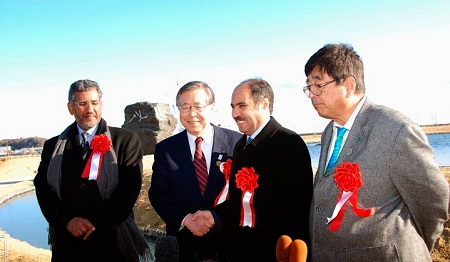
After completion of the Memorial Japanese Garden for Kuwait Fukushima Friendship on February 22, 2014. From right to left in the photo, Director Yoshitaka Abe, Ambassador Al-Otaibi, Fukushima Prefecture Governor Yuhei Sato, KISR Director Al-Mutairi.
The ceremony was sponsored by Fukushima Prefecture Governor Yuhei Sato. Ambassador Al-Otaibi, Dr. Naji Al-Mutairi, Director General of Kuwait Institute for Scientific Research, and Aquamarine Fukushima Director Yoshitaka
Abe gave remarks.
3 million dollar (about 300 million yen) aid for restoration and reconstruction was specially arranged by the Amir Al-Sabah of Kuwait who visited Japan on March, 2012. Current Director Yoshitaka Abe was stationed at Kuwait Institute for Scientific Research (KISR) in the latter half of 1960s, and his friends from that time helped restoration and reconstruction of Aquamarine Fukushima heavily damaged by the earthquakes and tsunami. On July 13, “Ceremony Commemorating Restoration and Reconstruction Donation from Kuwait” was held and friendship/partnership was established between KISR and Fukushima Marine Science Museum – Aquamarine Fukushima.
In the dedication ceremony held this year, Governor Sato said in his greeting remark, “I express my gratitude for the aid sent to Fukushima Prefecture from Kuwait since the great earthquakes. At the same time, I express my deep gratitude for the Amir of the State of Kuwait who provided 3 million dollars for restoration and reconstruction of Aquamarine Fukushima.” He concluded his remark by saying, “The restoration of Aquamarine Fukushima is a symbol of the restoration of Fukushima Prefecture, and the newly opened Memorial Garden is a testimony to the ties of friendship between Kuwait and Japan.”
(Photos provided by Kuwaiti Embassy to Japan)
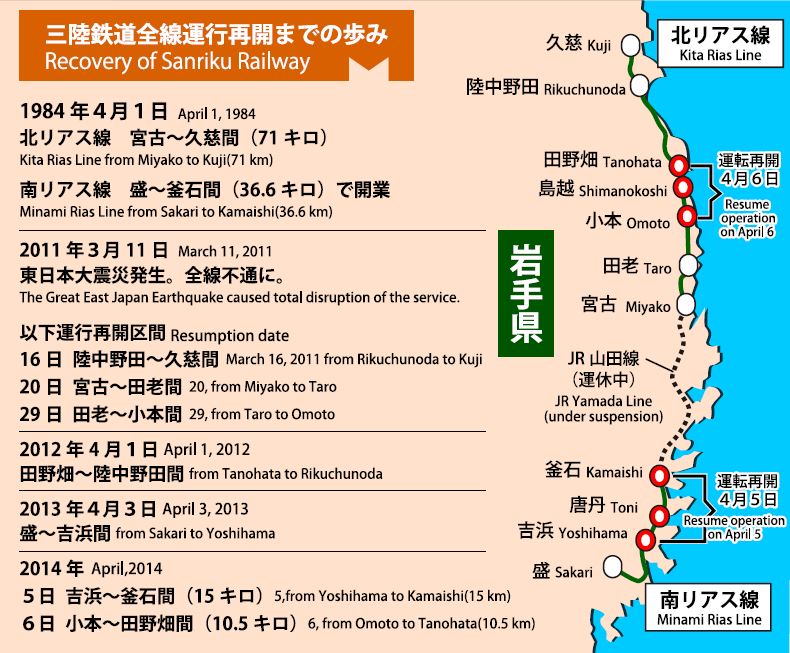
More articles available in the electronic “Salaam Quarterly Bulletin”, No.10, May 2014.
